|
12 - PHOBOS:
MALFUNCTION OR STAR WARS INCIDENT?
On October 4, 1957, the
Soviet Union launched Earthlings’ first artificial satellite.
Sputnik 1, and set Mankind on a road that has led Man to the Moon
and his spacecraft to the edge of the Solar System and beyond.
On July 12, 1988, the Soviet Union launched an unmanned spacecraft
called Phobos 2 and may have provided Mankind with its first Star
Wars incident—not the “Star Wars” nickname of America’s Strategic
Defense Initiative (SDI), but a war with people from another world.
Phobos 2 was one of two unmanned satellites, the other being Phobos
1, that were set off from Earth in July 1988, headed toward the
planet Mars. Phobos 1, reportedly because of a radio command error,
was lost two months later. Phobos 2 arrived safely at Mars in
January 1989 and entered into orbit around Mars as the first step at
its destination toward its ultimate goal—to transfer to an orbit
that would make it fly almost in tandem with
the Martian moonlet
called Phobos (hence the spacecraft’s name) and explore the moonlet
with highly sophisticated equipment that included two packages of
instruments to be placed on the moonlet’s surface.
All went well until Phobos 2 aligned itself with Phobos, the Martian
moonlet. Then, on March 28, 1989, the Soviet mission control center
acknowledged sudden communication “problems” with the spacecraft;
and Tass, the official Soviet news agency, reported that,
“Phobos 2
failed to communicate with Earth as scheduled after completing an
operation yesterday around the Martian moon Phobos. Scientists at
mission control have been unable to establish stable radio contact.”
These admissions left the impression that the problem was not
incurable and were accompanied by assurances that mission control scientists
were engaged in maneuvers to reestablish contact with the
spacecraft. Soviet space program officials as well as many Western
specialists were aware that the Phobos mission represented an
immense investment in terms of finance, planning, effort, and
prestige. Although launched by the Soviets, the mission in reality
represented an international effort on an unprecedented scale, with
more than thirteen European countries (including the European Space
Agency and major French and West German scientific institutions)
participating officially and British and American scientists
participating “personally” (with their governments1 knowledge and
blessing).
It was thus understandable that the “problem” was at
first represented as a break in communications that could be
overcome in a matter of days. Soviet television and press reports
played down the seriousness of the occurrence, emphasizing that
attempts were being made to reestablish links with the spacecraft.
In fact, American scientists associated with the program were not
officially informed of the nature of the problem and were led to
believe that the communications breakdown was caused by the
malfunction of a low-power backup transmitting unit that had been in
use since the principal transmitter had failed earlier.
But on the next day, while the public was still being reassured that
a resumption of contact with the spacecraft was achievable, a
high-ranking official at Glavkosmos, the Soviet space agency, hinted
that there indeed was no such hope. “Phobos 2 is ninety-nine percent
lost for good,” Nikolai A. Simyonov said; on that day, his choice of
words —not that contact with the spacecraft was lost but that the
spacecraft itself was “lost for good”—was not paid any particular
heed.
On March 30, in a special report from Moscow to
The New York
Times, Esther B. Fein mentioned that Vremya, the main evening news
program on Soviet television, “rapidly rattled off the bad news
about Phobos” and focused its report instead on the successful
research the spacecraft had already accomplished. Soviet scientists
appearing on the program,
“displayed some of the space images, but
said it was still not clear what clues they offered to understanding
Mars, Phobos, the Sun and interplanetary space.”
What “images” and what “clues” were they talking about?
This became clearer the following day, when reports published in the
European press (but for some reason not in the U.S. media) spoke of
an “unidentified object” that was seen “in the final pictures taken
by the spaceship,” which showed an “inexplicable” object or
“elliptical shadow” on Mars. This was an avalanche of puzzling words
out of Moscow!
The Spanish daily La Epoca, for example (Fig. 92),
headlined the dispatch by the Moscow correspondent of the European
news agency EFE “Phobos 2 Captured Strange Photos of Mars Before
Losing Contact With Its Base.”
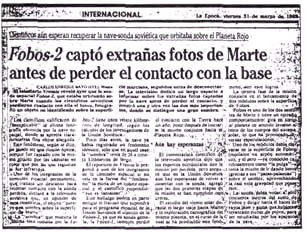
Fig. 92
The text of the dispatch, in
translation, read as follows:
The TV newscast “Vremya” revealed yesterday that the space probe
Phobos 2, which was orbiting above Mars when Soviet scientists lost
contact with it on Monday, had photographed an unidentified object
on the Martian surface seconds before losing contact.
The TV broadcast devoted a long segment to the strange pictures
taken by the spaceship before losing contact, and Figure 92 showed the two most important
pictures, in which a large shadow is visible in one of the pictures
and in the other. Scientists characterized the final picture taken
by the spaceship, in which the thin ellipse can be clearly seen, as
“inexplicable.”
The phenomenon, it was stated, could not be an optical illusion
because it was captured with the same clarity both by color cameras
as well as by cameras taking infrared images.
One of the members of the Permanent Space Commission who had worked
around the clock to reestablish contact with the lost space probe
stated on Soviet television that in the opinion of the commission’s
scientists the object “looked like a shadow on the surface of Mars.”
According to calculations by researchers from the Soviet Union the
“shadow” that the last photo taken by Phobos 2 shows is some twenty
kilometers [about 12.5 miles] long.
A few days earlier, the spaceship had already recorded an identical
phenomenon, except that in that instance the “shadow” was between
twenty-six to thirty kilometers [about 16 to 19 miles] long.
The reporter from “Vremya” asked one of the members of the special
commission if the shape of the “phenomenon” didn’t suggest to him a
space rocket, to which the scientist responded, “This is to
fantasize.” (Here follow details of the mission’s original assignments.)
Needless to say, this is an amazing and literally “out of this
world” report that raises as many questions as it answers.
The loss
of contact with the spacecraft was associated, by implication if not
in so many words, with the observation by the spacecraft of “an
object on the Martian surface seconds before.” The culprit “object”
is described as “a thin ellipse” and is also called “a phenomenon”
as well as “a shadow.” It was observed at least twice—the report
does not state whether in the same location on the surface of
Mars—and is capable of changing its size: the first time it was
about 12,5 miles long; the second and fatal time, about 16 to 19
miles long. And when the “Vremya” reporter wondered whether it was a “space rocket,” the scientist responded,
“This is to fantasize.” So, what was—or is—it?
The authoritative weekly Aviation Week & Space Technology, in its
issue of April 3, 1989, printed a report of the incident based on
several sources in Moscow, Washington, and Paris (the authorities in
the last being deeply involved because an equipment malfunction
would have reflected badly on the French contribution to the
mission, whereas an “act of God” would exonerate the French space
industry).
The version given AW&ST treated the occurrence as a
“communications problem” that remained unresolved in spite of a week
of attempts to “re-establish contact.” It included the information
that program officials at the Soviet Space Research Institute in
Moscow said that the problem occurred “after an imaging and data
gathering session,” following which Phobos 2 had to change the
orientation of its antenna.
“The data-gathering segment itself
apparently proceeded as planned, but reliable contact with Phobos 2
could not be established afterward.”
At the time, the spacecraft was
in a near-circular orbit around Mars and in the phase of “final
preparations for the encounter with Phobos” (the moonlet).
While this version attributed the incident to a
“loss-of-communications” problem, a report a few days later in
Science (April 7, 1989) spoke of “the apparent loss of Phobos
2”—loss of the spacecraft itself, not just of the communications
link with it. It happened, the prestigious journal stated, “on 27
March as the spacecraft turned from its normal alignment with Earth
to image the tiny moon Phobos that was the primary mission target.
When it came time for the spacecraft to turn itself and its antenna
automatically back toward Earth, nothing was heard.”
The journal then continued with a sentence that remains as
inexplicable as the whole incident and the “thin ellipse” on the
surface of Mars. It states:
A few hours later, a weak transmission was received, but controllers
could not lock onto the signal. Nothing was heard during the next
week.
Now, as a rereading of all the previous reports and statements will
confirm, the incident was described as a sudden and total loss of the “communications
link.” The reason given was that the spacecraft, having turned its
antennas to scan Phobos, failed to turn its antenna back toward
Earth due to some unknown reason. But if the antenna remained stuck
in a position facing away from Earth, how could “a weak
transmission” be received “a few hours later”? And if the antenna
did in fact turn itself back toward Earth properly, what caused the
abrupt silence for several hours, followed by the transmission of a
signal too weak to be locked onto?
The question that arises is indeed a simple one: Was the spacecraft
Phobos 2 hit by “something” that put it out of commission, except
for a last gasp in the form of a weak signal hours later?
There was one more report, from Paris, in AW&ST of April 10, 1989.
Soviet space scientists, it said, suggested that Phobos 2 “did not
stabilize itself on the proper orientation to have the high-gain
antenna pointing earthward.” This obviously puzzled the editors of
the magazine because, its report said, the Phobos2 spacecraft was
“three-axis stabilized” by technology developed for the Soviet Venera spacecraft, which had performed perfectly on Venus missions.
The mystery thus is, what caused the spacecraft to destabilize
itself? Was it a malfunction, or was there an extraneous
cause—perhaps an impact?
The weekly’s French sources provided this tantalizing detail:
One controller at the Kaliningrad control center said the limited
signals received after conclusion of the imaging session gave him
the impression he was “tracking a spinner.” Phobos 2, in other
words, acted as if it was in a spin. Now, what was Phobos 2
“imaging” when the incident occurred? We already have a good idea
from the “Vremya” and European press agency reports.
But here is
what the AW&ST report from Paris states, quoting Alexander Dunayev,
chairman of the Soviet Glavkosmos space administration:
One image appears to include an
odd-shaped object between the spacecraft and Mars. It may be
debris in the orbit of Phobos or could be Phobos 2’s autonomous
propulsion
sub-system that was jettisoned after the spacecraft was injected
into Mars orbit—we just don’t know.”
This statement must have been
made with quite a tonguein-cheek attitude. The Viking orbiters left
no debris in Mars orbit, and we know of no other “debris” resulting
from Earth originated activities. The other “possibility,” that the
object orbiting Mars between the planet and the spacecraft Phobos 2
was a jettisoned part of the spacecraft, can be readily dismissed
once one looks at the shape and structure of Phobos 2 (Fig. 93);
none of its parts had the shape of a “thin ellipse.”
Moreover, it
was disclosed on the “Vremya” program that the “shadow” was 12.5,
16, or 19 miles long. Now, it is true that an object can throw a
shadow much longer than itself, depending on the angle of sunlight;
still, a part of Phobos 2 that was only a few feet in length could
hardly throw a shadow measured in miles. Whatever had been observed
was neither debris nor a jettisoned part.

Fig. 93
At the time I wondered why the official speculation omitted what was
surely the most natural and believable third possibility, that what
had been observed was indeed a shadow—but the shadow of Phobos, the
Martial moonlet itself. It has Figure 93 most often been described as “potato-shaped”
(Fig. 94) and measures about seventeen miles across—just about the
size of the “shadow” mentioned in the initial reports. In fact. I
recalled seeing a Mariner 9 photograph of an eclipse on Mars caused
by the shadow of Phobos.
Couldn’t that be, I thought, what the fuss
was all about, at least regarding the “apparition,” if not what had
caused the spacecraft, Phobos 2, to be lost? The answer came about
three months later. Pressed by their international participants in
the Phobos missions to provide more definitive data, the Soviet
authorities released the taped television transmission Phobos 2 sent
in its last moments—except for the last frames, taken just seconds before the spacecraft
fell silent.

Figure 94
The television clip was shown by some TV stations in
Europe and Canada as part of weekly “diary” programs, as a curiosity
and not as a hot news item.
The television sequence thus released focused on two anomalies. The
first was a network of straight lines in the area of the Martian
equator; some of the lines were short, some longer, some thin, some
wide enough to look like rectangular shapes “embossed” in the
Martian surface. Arranged in rows parallel to each other, the
pattern covered an area of some six hundred square kilometers (more
than two hundred thirty square miles). The “anomaly” appeared to be
far from a natural phenomenon.
The television clip was accompanied by a live comment by Dr. John Becklake of England’s Science Museum. He described the phenomenon as
very puzzling, because the pattern seen on the surface of Mars was
photographed not with the spacecraft’s optical camera but with its
infrared camera—a camera that takes pictures of objects using the
heat they radiate, and not by the play of light and shadow on them.
In other words, the pattern of parallel lines and rectangles
covering an area of almost two hundred fifty square miles was a
source of heat radiation.
It is highly unlikely that a natural
source of heat radiation (a geyser or a concentration of radioactive
minerals under the surface, for example) would create such a perfect
geometric pattern. When viewed over and over again, the pattern
definitely looks artificial; but what it was, the scientist said, “I
certainly don’t know.”
Since no coordinates for the precise location of this “anomalous
feature” have been released publicly, it is impossible to judge its
relationship to another puzzling feature on the surface of Mars that
can be seen in
Mariner 9 frame 4209-75. It is also located in the
equatorial area (at longitude 186.4) and has been described as
“unusual indentations with radial arms protruding from a central
hub” caused (according to NASA scientists) by the melting and
collapse of permafrost layers.
The design of the features, bringing
to mind the structure of a modern airport with a circular hub from
which the long structures housing the airplane gates radiate, can be
better visualized when the photograph is reversed (showing
depressions as protrusions—Fig. 95).
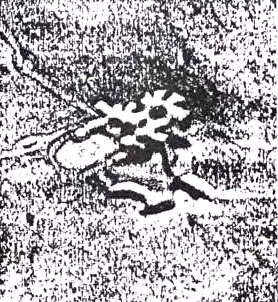
Fig. 95
We now come
to the second “anomaly” shown on the television segment. Seen on the
surface of Mars was a clearly defined dark shape that could indeed
be described, as it was in the initial dispatch from Moscow, as a
“thin ellipse” (Plate N is a still from the Soviet television clip).
It was certainly different from the shadow of Phobos recorded
eighteen years earlier by Mariner 9 (Plate O). The latter cast a
shadow that was a rounded ellipse and fuzzy at the edges, as would
be cast by the uneven surface of the moonlet.
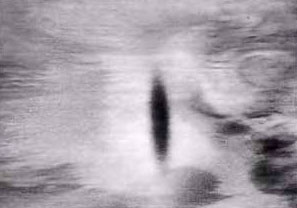
Plate N
The “anomaly” seen in
the Phobos 2 transmission was a thin ellipse with very sharp rather
than rounded points (the shape is known in the diamond trade as a
“marquise”) and the edges, rather than being fuzzy. Plate N stood out sharply against a kind of halo on the
Martian surface. Dr. Becklake described it as “something that is
between the spacecraft and Mars, because we can see the Martian
surface below it,” and stressed that the object was seen both by the
optical and the infrared (heat-seeking) camera. All these reasons
explain why the Soviets have not suggested that the dark, “thin
ellipse” might have been the shadow of the moon let.
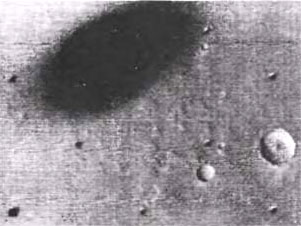
Plate O
While the image was held on the screen,
Dr. Becklake explained that
it was taken as the spacecraft was aligning itself with Phobos (the
moonlet).
“As the last picture was halfway through,” he said, “they
[Soviets] saw something which should not be there.”
The Soviets, he
went on to state, “have not yet released this last picture, and we
won’t speculate on what it shows.”
Since the last frame or frames have not yet been publicly released
even a year after the incident, one can only speculate, surmise, or
believe rumors, according to which the last frame, Plate O halfway through its
transmission, shows the “something that should not be there” rushing
toward Phobos 2 and crashing into it, abruptly interrupting the
transmission.
Then there was, according to the reports mentioned
earlier, a weak burst of transmission some hours later, too garbled
to be clear. (This report, incidentally, belies the initial
explanation that the spacecraft could not turn its antennas back to
an Earth-transmitting position).
In the October 19, 1989 issue of Nature, Soviet scientists published
a series of technical reports on the experiments Phobos 2 did manage
to conduct; of the thirty-seven pages, a mere three paragraphs deal
with the spacecraft’s loss. The report confirms that the spacecraft
was spinning, either because of a computer malfunction or because
Phobos 2 was “impacted” by an unknown object (the theory that the
collision was with “dust particles” is rejected in the report).
So what was it that collided or crashed into Phobos 2, the
“something that should not be there”? What do the last frame or frames, still secret, show? In his careful
words to AW&ST, the chairman of the Soviet equivalent of NASA
referred to that last frame when he tried to explain the sudden loss
of contact, saying,
“One image appears to include an odd-shaped
object between the spacecraft and Mars.”
If not “debris,” or “dust,” or a “jettisoned part of Phobos 2,” what
was the “object” that all accounts of the incident now admit
collided with the spacecraft—an object with an impact strong enough
to put the spacecraft into a spin, an object whose image was
captured by the last photographic frames? “We just don’t know,” said
the chief of the Soviet space program.
But the evidence of an ancient space base on Mars and the odd-shaped
“shadow” in its skies add up to an awesome conclusion:
What the secret frames hide is evidence that the loss of Phobos 2
was not an accident but an incident. Perhaps the first incident in a
Star Wars—the shooting down by Aliens from another planet of a
spacecraft from Earth intruding on their Martian base.
Has it occurred to the reader that the Soviet space chief’s answer,
“We just don’t know” what the “odd-shaped object between the
spacecraft and Mars” was, is tantamount to calling it a UFO—an
Unidentified Flying Object?
For decades now, ever since the phenomenon of what was first called
Flying Saucers and later UFOs became a worldwide enigma, no
self-respecting scientist would touch the subject even with a ten
foot pole—except, that is, to ridicule the phenomenon and whoever
was foolish enough to take it seriously. The “modern UFO era,”
according to Antonio Huneeus, a science writer and internationally
known lecturer on UFOs, began on June 24, 1947, when Kenneth Arnold,
an American pilot and businessman, sighted a formation of nine
silvery disks flying over the Cascade Mountains in the state of
Washington. The term “Flying Saucer” that then came into vogue was
based on Arnold’s description of the mysterious objects.
While the “’Arnold incident” was followed by alleged sightings
across the United States and other parts of the world, the UFO case
deemed most significant and one still discussed (and dramatized on
television) is the alleged crash of an “alien spacecraft” on July 2,
1947—a week after the Arnold sighting—on a ranch near Roswell, New
Mexico. That evening a bright, disk-shaped object was seen in the
area’s skies; the next day a rancher, William Brazel, discovered
scattered wreckage in his field northwest of Roswell.
The wreckage
and the “metal” of which it was made looked odd, and the discovery
was reported to the nearby Army Air Corps base at Roswell Field
(which then had the world’s only nuclear-weapons squadron.) Major
Jesse Marcel, an intelligence officer, together with an officer from
the counterintelligence corps, went to examine the debris. The
pieces, engineered in various shapes, looked and felt like balsa
wood but were not wood; they would neither burn nor bend, no matter
how the investigators tried. On some beam-shaped pieces there were
geometric markings that were later referred to as “hieroglyphics.”
On returning to the base, the officer in charge instructed the
base’s public relations officer to notify the press (in a release
dated July 7, 1947) that AAF personnel had retrieved parts of a
“crashed flying saucer.” The release made headline news in The
Roswell Daily Record (Fig. 96) and was picked up by a press wire
service in Albuquerque, New Mexico. Within hours a new official
statement, superseding the first, claimed instead that the debris
was part of a fallen weather balloon. Newspapers printed the
retraction; and, according to some reports, radio stations were
ordered to stop broadcasting the first version by being told, “Cease
transmission. National security item. Do not transmit.”
In spite of the revised version and ensuing official denials
of any “flying saucer” incident at Roswell, many of those
personally involved in that incident persist, to this very day,
in adhering to the first version. Many also assert that at a nearby
crash site of another “flying saucer” (in an area west of Socorro,
New Mexico), civilian witnesses had seen not only the wreckage but
also several bodies of dead humanoids.
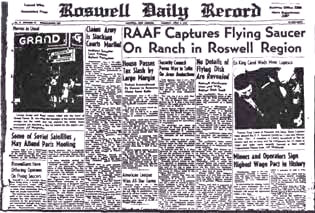
Figure 96
These
bodies, as well as bodies allegedly of “aliens” who crashed
after these two events, have been variously reported to have
undergone examination at Wright-Patterson Air Force Base in Ohio.
According to a document known in UFO circles as
MJ-12 or Majestic-12
(the two, some claim, are not identical), President Truman formed,
in September, 1947, a blue-ribbon, top-secret committee to deal with
the Roswell and related incidents, but the authenticity of this
document remains unverified.
What is known for a fact is that
Senator Barry Goldwater, who either chaired or was a senior member
of U.S. Senate committees on Intelligence, Armed Services, Tactical
Warfare, Science, Technology, and Space and others with a bearing on
the subject, was repeatedly refused admission to a so-called Blue
Room at that air base.
“I have long ago given up acquiring access to
the so-called blue room at Wright-Patterson, as I have had one long
string of denials from chief after chief,” he wrote to an inquirer
in 1981.
“This thing has gotten so highly classified... it is
just impossible to get anything on it.”
Reacting to continued reporting of UFO sightings and unease about
excessive official secrecy, the U.S. Air Force conducted several
investigations of the UFO phenomenon through such projects as Sign, Grudge, and
Blue Book. Between 1947 and 1969 about thirteen thousand reports of
UFOs were investigated, and they were by and large dismissed as
natural phenomena, balloons, aircraft, or just imagination. Some
seven hundred sightings, however, remained unexplained.
In 1953, the
U.S. Central Intelligence Agency’s Office of Scientific Intelligence
convened a panel of scientists and government officials. Known as
the Robertson Panel, the group spent a total of twelve hours viewing
UFO films and studying case histories and other information and
found that “reasonable explanations could be suggested for most
sightings. The evidence presented, it was reported, showed how the
remaining cases could not be explained by probable causes, “leaving
‘extra-terrestrials’ as the only remaining explanation in many
cases,” although, the panel noted, “present astronomical knowledge
of the solar system makes the existence of intelligent beings. . .
elsewhere than on the Earth extremely unlikely.”
While official
“debunking” of UFO reports continued (another investigation along
the same lines and with similar conclusions was the officially
commissioned Scientific Study of Unidentified Flying Objects by the
University of Colorado, conducted from 1966 to 1969), the number of
sightings and “encounters” continued to rise, and civilian amateur
investigative groups have sprung up in numerous countries. The
encounters are now classified by these groups; those of the “second
kind” are instances where physical evidence (landing markings or
interference with machinery) is left behind by the UFOs; and those
of the “third kind,” where contact takes place with the UFO’s
occupants.
Descriptions of the UFOs once were varied, from “flying
saucers” to “cigar-shaped.” Now most describe them as circular
in construction and, when landing, as resting on three or
four extended legs. Descriptions of the occupants also are more
uniform: “humanoids” three to four feet tall, with large, hairless
heads and very big eyes (Fig. 97a, b). According to a
purported eye-witness report by a military intelligence officer
who saw,
“recovered UFOs and alien bodies” at a “secret base
in Arizona,” the humanoids “were very, very white; there
were no ears, no nostrils. There were only openings: a very small
mouth and their eyes were large. There was no facial hair, no
head hair, no pubic hair. They were nude. I think the tallest
one could have been about three-and-a-half feet, maybe a little
taller.”
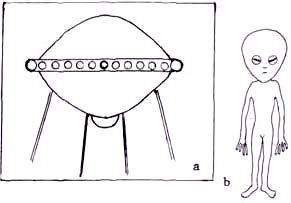
Figure 97
The witness added that he saw no genitals and no breasts, although
some humanoids looked male and some female.
The multitude of people reporting sightings or contacts come from
every geographical or occupational background. President Jimmy
Carter, for example, disclosed in a campaign speech in 1976 that he
had seen a UFO. He moved to “make every piece of information this
country has about UFO sightings available to the public and the
scientists”; but for reasons that were never given, his campaign
promise was not kept.
Besides the official U.S. policy of
“debunking” UFO reports, what has irked UFO believers in the United
States is the official tendency to give the impression that
government agencies have lost interest even in investigating UFO
reports, whereas it has repeatedly come to light that this or that
agency, including NASA, is keeping a close eye on the subject. In
the Soviet Union, on the other hand, the Institute of Space Research
published in 1979 an analysis of "Observations of Anomalous
Atmospheric Phenomena
in the USSR” (“’anomalous atmospheric phenomena” is the Russian term
for UFOs), and in 1984 the Soviet Academy of Sciences formed a
permanent commission to study the phenomena. On the military side,
the subject came under the jurisdiction of the GRU (Chief
Intelligence Directorate of the Soviet General Staff); its orders
were to discover whether UFOs were “secret vehicles of foreign
powers,” unknown natural phenomena, or “manned or unmanned
extraterrestrial probes engaged in the investigation of Earth.”
Numerous reported or purported sightings in the Soviet Union
included some by Soviet cosmonauts. In September 1989, the Soviet
authorities took the significant step of having Tass, the official
news agency, report a UFO incident in the city of Voronezh in a
manner that made front pages worldwide; in spite of the usual
disbelief, Tass stood by its story. The French authorities have also
been less “debunkative” (to coin a word) than U.S. officials. In
1977 the French National Space Agency (CNES), headquartered in
Toulouse, established the Unidentified Aerospace Phenomena Study
Group (GEPAN); it was recently renamed the Service d’Expertise des
Phenomenes de Rentree Atmospherique, with the same task of following
up and analyzing UFO reports.
Some of the more celebrated UFO cases
in France included follow-up analyses of the sites and soils where
the UFOs were seen to have landed, and the results showed the
“presence of traces for which there is no satisfactory explanation.”
Most French scientists have shared the disdain of their colleagues
from other countries for the subject, but among those who did get
involved and voiced an opinion, the consensus has been to see in the
phenomena “a manifestation of the activities of extraterrestrial
visitors.”
In Great Britain, the veil of secrecy over the UFO
phenomenon has held tight in spite of such efforts as the inquiring
UFO Study Group of the House of Lords initiated by the Earl of Clancarty (a group I had the privilege to address in 1980). The
British experience, as well as that of many other countries, is
reported in some detail in Timothy Good’s book
Above Top Secret
(1987). The wealth of documents quoted or reproduced in Good’s book
leads to the conclusion that at first the various governments
“covered up” their findings because UFOs were suspected of being advanced aircraft of another superpower, and
admission of the enemy’s superiority was not in the national
interest.
But once the extraterrestrial nature of the UFOs became
the primary guess (or knowledge), the memory of such panics as was
caused by Orson Wells' “War of the Worlds" radio broadcast was
used as the rationale for what so many UFO enthusiasts call a cover
up.
The real problem many have with UFOs is the lack of a cohesive and
plausible theory to explain their origin and purpose. Where do they
come from? Why?
I myself have not encountered a UFO, to say nothing of being
abducted and experimented upon by humanlike beings with elliptical
heads and bulging eyes—incidents witnessed and experienced, if such
claims be true, by many others. But when asked for my opinion,
whether I “believe in UFOs,” I sometimes answer by telling a story.
Let us imagine, I say to the people in the room or the auditorium in
which I am speaking, that the entrance door is thrust open and a
young man bursts in, breathless from running and obviously agitated,
who ignores the proceedings and just shouts, “You wouldn’t believe
what happened to me!”
He then goes on to relate that he was out in
the countryside hiking, that it was getting dark and he was tired,
that he found some stones and put his knapsack on them as a cushion,
and that he fell asleep. Then he was suddenly awakened, not by a
sound but by bright lights. He looked up and saw beings going up and
down a ladder. The ladder led skyward, toward a hovering, round
object. There was a doorway in the object through which light from
inside shone out. Silhouetted against the light was the commander of
the beings. The sight was so awesome that our lad fainted. When he
came to, there was nothing to be seen. Whatever had been there was
gone.
Still excited by his experience, the young man finishes the story by
saying he was no longer sure whether what he had seen was real or
just a vision, perhaps a dream. What do we think? Do we believe him?
We should believe him if we believe the Bible, I say, because what I
had just related is the tale of Jacob’s vision as told in Genesis,
chapter 7. Though it was a vision seen in a dreamlike trance, Jacob
was certain that the sight was real, and he said,
Surely Yahweh is present in
this place, and I knew it not...
This is none other but an abode of the gods, and this is the gateway
to heaven.
I once pointed out at a conference where other speakers delved into
the subject of UFOs that there is no such thing as Unidentified
Flying Objects. They are only unidentified or unexplainable by the
viewer, but those who operate them know very well what they are.
Obviously, the hovering craft that Jacob saw was readily identified
by him as belonging to the Elohim, the plural gods. What he did not
know, the Bible makes clear, was only that the place where he had
slept was one of their lift-off pads.
The biblical tale of the heavenward ascent of the Prophet Elijah
describes the vehicle as a Fiery Chariot. And the
Prophet Ezekiel,
in his well-documented vision, spoke of a celestial or airborne
vehicle that operated as a whirlwind and could land on four wheeled
legs.
Ancient depictions and terminology show that a distinction was made
even then between the different kinds of flying machines and their
pilots. There were the rocketships (Fig. 98a) that served as shuttle
craft and the orbiters, and we have already seen what the Anunnaki
astronauts and the orbiting Igigi looked like. And there were the
“whirlbirds” or “sky chambers” that we now call VTOLs (Vertical
Take-Off and Landing aircraft) and helicopters; how these looked in
antiquity is depicted in a mural at a site on the east side of the
Jordan, near the place from which Elijah was carried heavenward
(Fig. 98b). The goddess Inanna/Ishtar liked to pilot her own “sky
chamber,” at which time she would be dressed like a World War I
pilot (Fig. 98c).
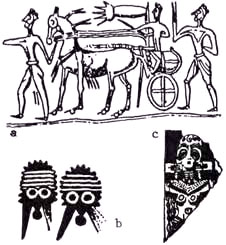
Figure 98
But other depictions were also found—clay figurines of human-looking
beings with elliptical heads and large, slanting eyes
|

Figure 99
|
(Fig. 99)—an
unusual feature of whom was their bisexuality (or lack of it): their
lower parts depicted the male member overlaid or dissected by the
opening of a female vagina.
Now, as one looks at the drawings of the “humanoids” by
those who claim to have seen the occupants of UFOs, it is
obvious they do not look like us—which means they do not look like
the Anunnaki. Rather, they look like the odd humanoids depicted by
the ancient figurines.
This similarity may hold an important clue to the identity of the
small creatures with smooth skins, no sex organs, no hair,
elliptical heads, and large odd eyes that are supposed to be
operating the purported UFOs. If the tales be true, then what the
“contactees” have seen are not the people, the intelligent beings,
from another planet—but their anthropoid robots.
And if even a tiny percentage of the reported sightings is true,
then the relatively large number of alien craft visiting Earth in
recent times suggests that they could not possibly come, in such
profusion and frequency, from a distant planet. If they come, they
must come from somewhere relatively close by.
And the only plausible candidate is Mars—and its moonlet Phobos.
The reasons
for the use of Mars as a jumping-off base for spacemen’s visits to
Earth should be clear by now. The evidence for my suggestion that
Mars had served in the past as a space base for the Anunnaki has
been presented. The circumstances in which Phobos 2 was lost
indicate that someone is back there on Mars—someone ready to destroy
what to them is an “alien” spacecraft. How does Phobos, the moonlet,
fit into all this?
Simply put, it tits very well.
To understand why, we ought to backtrack and list the reasons for
the 1989 mission to Phobos. At present Mars has two tiny satellites
named Phobos and Deimos. Both are believed to be not original moons
of Mars but asteroids that were captured into Mars orbit. They are
of the carbonaceous type (see the discussion of asteroids in
chapter
4) and therefore contain water in substantial amounts, mostly in the
form of ice just under the moonlets’ surfaces. It has been proposed
that with the aid of solar batteries or a small nuclear generator,
the ice could be melted to obtain water.
The water could then be separated into oxygen and hydrogen, for breathing
and as fuel. The hydrogen could also be combined with the moonlets”
carbon to make hydrocarbons. As do other asteroids and comets, these planetisimals contain nitrogen, ammonia, and other organic
molecules. All in all, the moonlets could become self-supporting
space bases, the gift of nature.
Deimos would be less convenient for such a purpose. It is only nine
by eight by seven miles in size and orbits some 15,000 miles away
from Mars. The much larger Phobos (seventeen by thirteen by twelve
miles) is only some 5,800 miles away from Mars—a short hop for a
shuttlecraft or transporter from one to the other. Because Phobos
(as does Deimos too) orbits Mars in the equatorial plane, Phobos can
be observed from Mars (or observe goings on upon Mars), between the
sixty fifth parallels north and south—a band that includes all the
unusual and artificial-looking features on Mars except “ Inca City.”
Moreover, because of its proximity, Phobos completes about 3.5
orbits around Mars in a single Martian day—an almost constant
presence.
Further recommending Phobos as a natural orbiting station around
Mars is its minuscule gravity, compared with that of Earth and even
of Mars. The power required for take-off from Phobos is no greater
than that required to develop an escape velocity of fifteen miles an
hour; conversely, very little power is needed to brake for a landing
on it.
These are the reasons the two Soviet spacecraft, Phobos 1 and 2,
were sent there. It was an open secret that the mission was a
scouting expedition for the intended landing of a “robotic rover” on
Mars in 1994 and the launching of a manned mission to Mars after
that, with a view to establishing a base thereon within the
following decade. Prearrival briefings at mission control in Moscow
revealed that the spacecraft carried equipment to locate “the
heat-emitting areas on Mars” and to obtain “a better idea of what
kind of life exists on Mars.” Although the provision, “if any,” was
quickly added, the plan to scan both Mars and Phobos not only with
infrared equipment but also with gamma-ray detectors hinted at a
very purposeful search.
After scanning Mars the two spacecraft were to turn their attention
entirely to Phobos. It was to be probed by radar as well as by the
infrared and gamma-ray scanners and was to be photographed by three television cameras.
Apart from such orbital scanning, the spacecraft were to drop two
types of landers to the surface of Phobos:
-
one, a stationary device
that would have anchored itself to the surface and transmitted data
over the long term
-
the other, a “hopper” device with springy legs
that was meant to hop and skip about the moonlet and report its
findings from all over it
There were still other experiments in the bag of tricks of Phobos 2.
It was equipped with an ion emitter and a laser gun that were to
shoot their beams at the moonlet, stir up its surface dust,
pulverize some of the surface material, and enable equipment aboard
the spacecraft to analyze the resultant cloud. At that point the
spacecraft was to hover a mere 150 feet above Phobos, and its
cameras were to photograph features as small as six inches.
What exactly were the mission planners expecting to discover at such
close range? It must have been an important objective, because it
later transpired that the “individual scientists” from the United
States who were involved in the mission’s planning and equipping
included Americans with experience in Mars research whose roles were
officially sanctioned by the United States government within the
framework of the improvement in U.S.-Soviet relations.
Also, NASA
had put at the mission’s disposal its Deep Space Network of radio
telescopes which has been involved not only in satellite
communications but also in the Search for Extraterrestrial
Intelligence (SETI) programs; and scientists at the JPL in Pasadena,
California, were helping track the Phobos spacecraft and monitor
their data transmissions. It also became known that the British
scientists who were participating in the project were in fact
assigned to the mission by the British National Space Centre.
With the French participation, guided by its National Space Agency
in Toulouse; the input by West Germany’s prestigious Max Planck
Institute; and the scientific contributions from a dozen other
European nations, the Phobos Mission was nothing short of a
concerted effort by modern science to lift the veil from Mars and
enlist it in Mankind’s course on the road to Space.
But was someone there, at Mars, who did not welcome this intrusion?
It is noteworthy that Phobos, unlike the
smaller and smooth surfaced Deimos, has peculiar features that have
led some scientists in the past to suspect that it was artificially
fashioned. There are peculiar “track marks” (Fig. 100) that run
almost straight and parallel to each other.
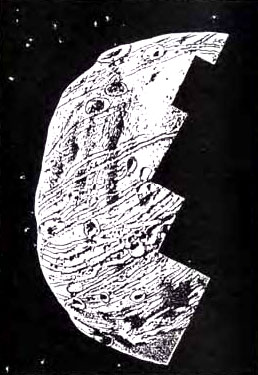 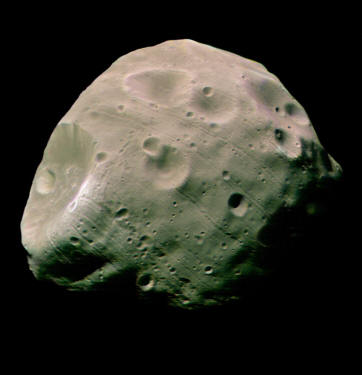
Figure 100
Their width is almost
uniform, some 700 to 1,000 feet, and their depth, too. is a uniform
75 to 90 feet (as far as could be measured from the Viking
orbiters). The possibility that these “’trenches,” or tracks, were
caused by flowing water or by wind has been ruled out, since neither
exist on Phobos. The tracks seem to lead to or from a crater that
covers more than a third of the moonlet’s diameter and whose rim is
so perfectly circular that it looks artificial (see Fig. 94
above).
What are these tracks or trenches, how did they come about, why do
they emanate from the circular crater, and does the crater lead into
the moonlet’s interior? Soviet scientists have thought that there
was something artificial about Phobos in general, because its almost
perfect circular orbit around Mars at such proximity to the planet
defies the laws of celestial motion: Phobos, and to some extent
Deimos, too, should have elliptical orbits that would have either
thrown them off into space or made them crash into Mars a long time
ago.
The implication that Phobos and Deimos might have been placed
in Mars orbit artificially by “someone” seemed preposterous. In
fact, however, the capture of asteroids and towing them to where
they would stay in Earth orbit has been deemed a technologically
achievable feat; so much so that such a plan was presented at the
Third Annual Space Development Conference held in San Francisco in
1984.
Richard Gertsch of the Colorado School of Mines, one of
several presenters of the plan, pointed out that,
“a startling
variety of materials exist” out in space;
“asteroids are
particularly rich in strategic minerals such as chromium, germanium
and gallium.”
“I believe that we have identified asteroids that are
accessible and could be exploited,” stated another presenter,
Eleanor F. Helin of JPL.
Have others, long ago, carried out ideas and plans that modern
science envisions for the future—bringing Phobos and Deimos, two
captured asteroids, into orbit around Mars to burrow into their
interiors?
In the 1960s it was noticed that Phobos was speeding up its orbit around Mars;
this led Soviet scientists to suggest that Phobos was lighter than
its size warrants. The Soviet physicist I. S. Shklovsky then offered
the astounding hypothesis that Phobos was hollow.
Other Soviet writers then speculated that Phobos was an,
“artificial
satellite” put into Mars orbit by “an extinct race of humanoids
millions of years ago.”
Others ridiculed the idea of a hollow
satellite and suggested that Phobos was accelerating because it is
drifting closer to Mars. The detailed report in Nature now includes
the finding that Phobos is even less dense than has been thought, so
that its interior is either made of ice or is hollow.
Were a natural crater and interior faults artificially enlarged and
carved out by “someone” to create inside Phobos a shelter, shielding
its occupants from the cold and radiation of space? The Soviet
report does not speculate on that; but what it says regarding the
“tracks” is illuminating. It calls them “grooves,” reports that
their sides are of a brighter material than the moonlet’s surface,
and, what is indeed a revelation, that in the area west of the large
crater, “new grooves can be identified”—grooves or tracks that were
not there when Mariner 9 and the Vikings took pictures of the
moonlet.
Since there is no volcanic activity on Phobos (the crater
in its natural shape resulted from meteorite impacts, not
volcanism), no wind storms, no rain, no flowing water—how did the
new grooved tracks come about? Who was there on Phobos (and thus on
Mars) since the 1970s? Who is on it now? For, if there is no one
there now, how to explain the March 27, 1989, incident?
The chilling possibility that modern science, catching up with
ancient knowledge, has brought Mankind to the first incident in a
War of the Worlds, rekindles a situation that has lain dormant
almost 5,500 years.
The event that parallels today’s situation has come to be known as
the Incident of the Tower of Babel. It is described in Genesis,
chapter 11, and in The Wars of Gods and Men I refer to Mesopotamian
texts with earlier and more detailed accounts of the incident. I
have placed it in 3450 B.C. and construed it as the first attempt by
Marduk to establish a space base in Babylon as an act of defiance
against Enlil and his sons.
In the biblical version, the people whom Marduk had gotten
to do the job were building, in Babylon, a city with a “tower
whose head shall reach the heaven” in which a Shem—a space
rocket—was to be installed (quite possibly in the manner depicted
on a coin from Byblos (see Fig. 101). But the other
deities were not amused by this foray of Mankind into the
space age; so
Yahweh came down to see the city
and the tower which the humans were building.
And he said to unnamed colleagues:
This is just the beginning of their undertakings;
From now on, anything that they shall scheme to do shall no longer
be impossible for them.
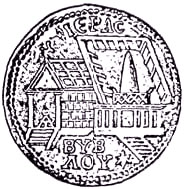
Figure 101
Come, let us go down and confuse their language so that they should
not understand each other’s speech. Almost 5,500 years later, the
humans got together and “spoke one language,” in a coordinated
international mission to Mars and Phobos.
And, once again, someone was not amused.
Back to Contents
Back to Phobos - A Strange "Thing"...
|












